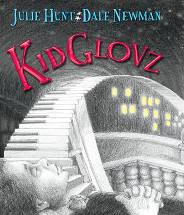Kid Glovz by Julie Hunt

Ill. by Dale Newman. Allen and Unwin, 2015. ISBN 9781742378527
Themes: fable, magic, music, friendship, resilience. The lavishly
produced cover of this Australian graphic fable with its embossed
musical notes invites the reader to pick it up. Inside Hunt's epic
tale with Newman's pencil rendered drawings, reminiscent of Brian
Selznick's The Invention of Hugo Cabret, tell a dark story
about a boy with a musical gift. His mother sewed her song with a
magical thread into his gloves before she died and they are the
source of his musical genius. Brought up by a mean guardian Kid
Glovz is exploited as a child prodigy: 'at two years of age he
played the minute waltz in thirteen seconds' p5. At concert halls
and competitions, for a fee, he plays the piano. 'Tonight this
brilliant child prodigy will play Rackhoven's Symphony No.3 in E
minor with his left hand while playing Fekonhoff's Sonata No. 563
with his right' p6. There is no joy in the music and Kid Glovz is
not allowed to play his own compositions. To keep him small he is
underfed and made to rehearse all day. One night a thief, called
Shoestring, tightrope walks into his room and offers friendship and
a way to escape. The ensuing action is complex and involves a gang
of thieves, giant goatherds, a hermit oracle and Splitworld Sam, a
central character, condemned to live between worlds for robbing the
dead, who lures the boys into the underworld. At times the story is
a little confusing with a prelude and dream sequences that are not
immediately obvious but generally the graphics add another dimension
to the story and the characters are particularly expressive and
beautifully rendered. Additional readings will reward as subtleties
are revealed. The friendship between the boys develops, though each
starts out pursuing self-interest in the end looking after each
other becomes more important.
Upper primary to middle school students, especially boys, will enjoy
the developing friendship but all ages can enjoy the graphics and in
spite of the scary bits, like most fables, it would be a good book
to read aloud to younger children.
Sue Speck